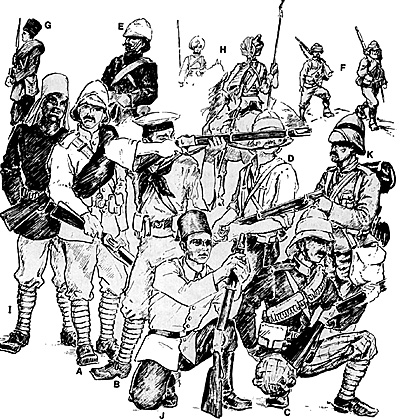 Britain fought two wars in the Sudan, the first in 1884-5, the second in
1896-8. In the first Sudan War British troops were committed to battle
after Egyptian troops had failed to achieve the aims Britain had imposed
on Egypt. After 1885 the British trained and officered Egyptian Army
carried on the brunt of the fighting with the Mahdist state on its borders.
The final war, the Reconquest, was begun by the Egyptian Army, who
once again did most-of the fighting until the last year of the war when
British troops were employed in large numbers for the last two battles.
Britain fought two wars in the Sudan, the first in 1884-5, the second in
1896-8. In the first Sudan War British troops were committed to battle
after Egyptian troops had failed to achieve the aims Britain had imposed
on Egypt. After 1885 the British trained and officered Egyptian Army
carried on the brunt of the fighting with the Mahdist state on its borders.
The final war, the Reconquest, was begun by the Egyptian Army, who
once again did most-of the fighting until the last year of the war when
British troops were employed in large numbers for the last two battles.
A. British Infantry, Khaki uniform, Suakin 1884
B. Naval Brigade, 1884-5 - note: this figure is wearing army pattern puttees
rather than the standard issue canvas gaiters.
C. Mounted Infantry, Suakin, 1884-5 - note trews.
D. Nile Column British Infantry in shirt sleeves. This was normal working order
while operating in the whale boats.
E. 19th Hussars, 1885.
F. Australian Infantry, Suakin, 1885. Note tall leather gaiters.
G. 17th Bengal Infantry, Sepoy, 1885.
H. Sowar, 9th Bengal Cavalry, 1885.
I. Sudanese infantrymen in blue jersey with kahki imma over the fez, 1896-8.
J. Egyptian Cavalryman, 1896-8.
K. British Infantry, 1898.
Jumbo Illustration (very slow: 256K)
In 1884-5 the British soldiers were armed with the single-shot breech-loading Martini-Henry rifle (carbine for the cavalry), crank operated multi-barrelled Gatling, Gardner and Nordenfeldt machine-guns, and small 7 pounder or 2.5" mountain guns with the occasional heavier field gun. The few Egyptian army troops deployed along with the British were at first armed with the single-shot Remington breech-loading rifle, but by the end of 1885 they, too, had the Martini-Henry. Indian troops in the 1885 campaign were armed with the earlier Snider-Enfield. In 1896- 98 British troops were armed with the magazine bolt-action LeeMetford rifle, firing a smokeless .303 cartridge, while the Egyptian army still used the Martini-Henry with black powder. The Maxim machine-gun was used by both armies, along with a variety of artillery pieces ranging from old Krupps to the most advanced field howitzers.
In both wars the British infantry regiments were organized into two battalions of eight 120 man companies each, and cavalry regiments had four 160 man squadrons each. Egyptian infantry battalions at first had four 170 man companies each, but by 1896 they had six 150 man companies each. Egyptian cavalry squadrons had 100 men each, artillery batteries generally had six guns with 113 men (the horse battery had 137 men), and Camel Corps companies 152 men each.
As the numbers given below will show, companies, battalions and regiments were never fielded at full strength. The Sudanese battalions of the Egyptian Army were chronically understrength because they were constantly on active service.
British and Egyptian Forces Sudan 1884-1898
Back to Table of Contents -- Courier Vol. VI No. 1
Back to Courier List of Issues
Back to Master Magazine List
© Copyright 1985 by The Courier Publishing Company.
This article appears in MagWeb.com (Magazine Web) on the Internet World Wide Web.
Other articles from military history and related magazines are available at http://www.magweb.com